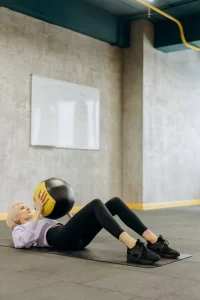How to Sing
Singing can be considered an art form in itself and something that almost anyone can do.
People are deeply attracted to the sounds and melody of music. Learning how to sing can be one of the most rewarding hobbies or pursuits for human beings (in my opinion).
Whether they have been active in music and singing since childhood or just starting to get their feet wet, almost everyone I know has some rhythmic backbone.
I must first ask you… Why are you interested in learning to sing?
Learn to sing online for free with my favourite singing program. The 30 Day Singer Program teaches you how to quickly. The program is available here.
While music is an integral part of human nature, it requires serious practice and dedication to become a good singer who can create a pleasant melody with his voice and sing in tune.
You can sing in the shower, and it’s fun. But singing isn’t easy. To be consistent and disciplined.
No matter what genre you sing, there are key tips every singer should remember or practice to be a successful singer. These steps will help you feel confident that you can sing.
Although you can make a living singing, it is very competitive.
Have you ever seen American Idol or ‘The Voice?
While most of these singers have been singing for a long time, only one succeeds and becomes an actual professional singer after the competition. This is how competitive the music industry is.
You can become a professional singer if you wish.
Let’s start with 12 essential components for being an excellent singer. Make sure you write these tips down to have them handy as you train to become the best or be the best.
It would help if you considered taking an online long-term singing course for daily practice and rapid singing advancement.
Proper breathing is essential to know how to control your breathing correctly to sing properly and for long periods.
You can start with basic breathing exercises to help you understand the pitches of your voice and train your vocal cords and lungs to keep those notes in your head longer.
Breathing exercises are also necessary to prevent any damage to your throat, which could lead to a shorter life expectancy for your singing dreams.
The best vocalists can properly breathe before, after and during their performances.
These are some exercises you can do to learn how to inhale properly. They will clear your throat and prepare you for peak performance.
Relax your throat muscles. You will be able to work through various tensions in your throat muscles, which will allow you to develop more diverse tonalities.
Slowly inhale, and imagine that the air you’re drawing in is thick and heavy. Actively work to inhale, moving the air under your belly button into your diaphragm. This dome-shaped muscle lies between your chest cavity and abdomen cavities. It is responsible for your respiratory movements and is crucial for any singer. Inhale, then exhale again.
– Use a feather to practice inhaling with your breath. This will improve your breathing control and increase your lung capacity. This exercise requires you to maintain a steady flow and not allow your diaphragm or lungs to collapse.
Breathe in for four counts, then exhale for four counts. Make a “hissing sound” by exhaling for four counts. You will gradually increase the time by inhaling for 6 counts and exhaling for 10 while making a “hissing” sound. Six counts in, 12 out. 2 counts in, 12 Out. 4 counts in, 16 out. 2 counts in, 16 of. Four counts in, 16 out. One count in, 20 outside. This hissing exhalation exercise will help you train your lungs to hold a longer note with less breath. You want to exhale with a consistent tone and volume.
Slowly inhale and imagine your lungs filling slowly as you count. Fill your lungs to 1/4; at 2 counts, half-full; 3 counts up; 3/4; 4 counts; empty. Continue counting to 12. Next, exhale slowly. You can start again. This time, you will divide your inhale into two sections: 1/2 count, 1 count, and 2 counts, complete. Continue counting to 10. The idea is to teach the body how to regulate its breathing.
Muscles Warm-Up
You might stretch before you think about preparing for a set of weights in an exercise program. Your throat muscles and vocal cords will also need some stretching to warm up before you can sing.
Slowly and carefully. Practice with different notes to loosen your vocal cords and prepare for work. This will prevent your vocal cords from becoming stiff or “cold” from too much use.
These are some exercises that you can do to get warm:
– Inhale through the mouth and out your lungs. Relax your stomach muscles and open your mouth. Inhale slowly. This should be repeated several times. Next, when you are ready to inhale, make a hissing sound with your breath. Then you can see how long you can keep the note inhaling while you inhale. To help stretch your vocal cords, practice different sounds like “fffffff”, “shhh”, and “ffffff”.
– Close your eyes, breathe normally, inhale through the nose, and exhale through the mouth. Relax your shoulders and ensure that your inhale fills all of your lungs. Keep your chest inflated while you work to empty your lungs. Although it may seem difficult at first, this is a great “stretch.”
Slowly count to 4, then breathe in slowly. Next, count to four and lift your head back up to its original position. Continue with the right ear and keep going for several more cycles.
Posture
Although it may seem not that important, it is vital to have the right posture.
When practising singing, make sure your feet are straight, and your knees are slightly bent. You don’t want your knees to lock up and cause you to pass out.
Your head should be up and your neck straight. However, your shoulders should be down, and your stomach should be relaxed.
For creating the perfect song, relaxation is essential. Your body should not be stressed, as this can cause you to alter or damage the sound you are creating.
Find Your Range.
You’ve learned how to properly breathe, strengthen your vocal chord muscles, and stand straight, so it is time to find out what your voice can do.
Women and men are on the average split between four major voice ranges: alto (low), soprano, and alto (high), for women, and tenor and bass (low), for men.
Notice: In this article, I also mention two additional voice ranges.
Start by making a sound and sticking to the volume and pitch you are most comfortable with.
Once you’ve found your natural pitch, you can start to increase the range to get to a higher note.
You have reached the maximum range on the high end of your throat feels swollen, or it is just too difficult to breathe.
To determine your low range, repeat the process with a low note. Do not exceed your natural range. This can cause harm to your vocal cords or cause great discomfort.
You can use singing notes that are not within your normal range. However, these methods can be very effective.
A musical reference scale can be found online to help you decide which notes to try.
It is important to start singing where you feel most comfortable and then add variation as you go.
Recording yourself singing is a great way to determine your pitch range. A simple melody is enough.
Then, copy the snippet and listen to how it sounds.
Record again if you feel your pitch is slipping in certain places. Focus on fixing those issues.
You might also want to consider buying or downloading free audio recording and analysis software. This will help you fine-tune your practise by visualizing when your voice is not at the right pitch.
Remember that everyone has a natural range in which their voices fall and that you are no exception.
A singer may find himself singing out of tune a lot of the time because he/she is trying to reach beyond their natural range.
You can expand your skills and practice more. This will allow you to master the basics, create a pleasing sound ( and avoid harming your vocal cords). But, as you learn and improve, it is important to stay within your comfort zone.
Keep hydrated
Even though you are careful not to put too much pressure on your throat, strain them the same way as muscles are stretched during exercise. It is important to drink lots of water and stay hydrated.
You may not realize that lukewarm is the best water to drink when practising singing. It will keep your vocal cords open and looser than cold water, which can make them tighten up.
Drinking or eating dairy products or other thick foods before singing can make it more difficult.
Christina Aguilera likes honey between vocal performances. This is one of many pro tips that you can learn from her online masterclass.
Vocal Control and Scale
It doesn’t matter how much you know about musical theory or practice; it is easy to learn how to follow a scale.
Scale is a set of notes sung in a line, going up in pitch then back down.
There are many types of scales. Practising with them can help you improve your singing voice.
It is important to train your voice to move along a range for vocal control.
Solfa is short for solfege and can be used to do useful exercises. It may also be known as the “do-re mi” scale.
Instead of singing formless notes, you can give each note a name and then sing them up and down the scale.
You can easily search the internet to find a working scale you can practice with.
Be sure you are not tone-deaf.
Unfortunately, tone deafness can be a serious disorder affecting many people.
This disorder can be described as being unable to match your voice and music properly.
Tone deafness means that you cannot distinguish between different tones on an instrument. It will also make it difficult to follow along with a song if you can’t feel its rhythm.
It is a rare occurrence for a person to be truly tone-deaf in the world.
To test for tone-deafness and see if you can distinguish between the notes, you can find an online ear test.
Tone deafness does not affect your ability to play a musical instrument or read music notes. This is a genetic condition that can’t be reversed.
Singing and your nose
The body’s soundboard is the nose, so learning to use it in singing will improve your overall sound control.
You can practice making either a more or less nasal sound depending on what type of singing you want.
Country music is more appealing than other types of music because they use nasal tones.
Nasal singing isn’t what you want. It tends to sound more squeaky than your voice can reach and won’t give it its full potential.
Nasal singing can be caused by improper tongue placement or a soft palate. Learning how to control these issues while singing will improve your vocal quality.
When you are looking into a mirror, spread your lips wide and focus on the back of your throat.
This organ attaches to your soft palate. When you yawn, you’ll notice that the palate moves upwards.
To force your tongue to touch your soft taste buds, you can also make certain sounds (such as the sounds in “sing”)
All this shows that you have control over the size and shape of your throat and mouth openings, affecting the quality and sound of your singing.
“M”, the “N”, and the “NG” sounds have stronger nasal resonance. “B”, D”, “G”, or “UH”, however, create fewer nasal sounds.
You can replace the nasal consonant sounds with these less nasal consonants. This will allow you to practice bringing your vocal cords back together, lowering your larynx and developing a more nasally singing voice.
Singing Diction
You can use diction to refer to your choice of words or how you pronounce them.
You aren’t choosing the words of the songs you cover, but how you sing them.
You want to ensure that each word is sung clearly at the beginning of your singing education and practice.
You want to be understood.
Here are some key points to remember when singing to have good diction.
Slow down and say the words clearly. Some singers speed up, making it difficult to understand. This is not the best place to begin if you’re a beginner. Your goal is to improve your vocal cords and build your body in a way that promotes healthy singing.
Ensure that you hear all the words and the first letters of every lyric when singing. You will be able to understand what you are saying.
– Learn the lyrics without signing. As if you were reading a poem, pronounce each word. music is generally considered poetry. You can practice clear pronunciation even after you sing.
Hearing and listening
It is essential to identify your pitch and to listen out for any inconsistencies. If you use recording equipment, you must hear your singing clearly while you sing. It is equally important to learn to listen to music and learn how to sing.
Keep your eyes open for these:
– A balanced pitch
– Your overall tone (adjust your pitch as you sing). This will require knowing your voice type, range and other factors for greater success.
– Balanced volume: You don’t want to oversing the music or for it to drown your voice.
– You should be able to pick out the voices of your fellow singers and the music of your band members if you’re part of a duo or band.
– Listening to your singing while you sing (or being able to pay attention and hear what you sound like while singing).
Practice, Practice, Practice.
Practice is key to improving your skills and your ability to excel.
You can’t just do vocal or breathing exercises and expect to be a master singer.
These exercises should be done regularly to keep your vocal cords strong and healthy before you start singing.
You can keep your vocal cords healthy by taking just ten minutes per day.
Record yourself singing songs and then playback the recordings. You’ll be surprised at the difference in how your voice sounds from what you imagined.
You can listen to music and playback the recording to compare your voice with the song. You can also listen to the recording and see any inconsistencies or poorly timed notes.
It can be difficult to learn skills like playing the guitar and singing simultaneously.
Consider Singing Lessons
Singing is an “unnatural” talent, but it can still be learned and improved by practising and receiving guidance from a skilled teacher.
If you’re struggling to understand the basics, you might find singing lessons for beginners near you.
An instructor can help you get started with your singing voice, such as unlocking your falsetto and head voices, respectively.
You can also find singing lessons online for free or through an online payment platform.
There is no wrong place to begin singing lessons. It is important to feel comfortable in your first few lessons. This will help you keep practising and motivate you.














Post Comment